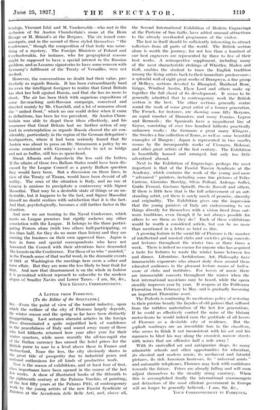A LKTTER PROM FLORENCE.
[To the Editor of the SPECTATOR.]
Sin,—From the point of view of the tourist industry, upon which the welfare of the city of Florence largely depends, the winter season and the spring so far have been distinctly disappointing. Last autumn alarmist articles in the foreign Press disseminated a quite unjustified lack of confidence In the peacefulness of Italy and scared away many of those who had hitherto returned here year after year for their winter quarters, while more recently the all-too-rapid rise of the Italian currency has caused the hotel prices for the British purse to soar to a level above those in France and Switzerland. None the less, the city obviously shares in the great tide of prosperity due to industrial peace and national enthusiasm for all kinds of productive work.
how is the season of exhibitions, and at least four of first. class importance have been opened in the course of the last few Weeks. A show of illustrated books of the fifteenth to the eighteenth century at the Palazzo Vecchio, of paintings of the last.fifty years at the Palazzo Pitti, of contemporary work by the young artists of the new Fascist Syndicate of Panders at the Accademia delle Belle Arti, and, above all.
the Second International Exhibition of Modern Engravings at the Parterre of San Gallo, have added unusual attractions to the already overloaded programme of the visitor.
The last in itself should be sufficiently interesting to attract collectors from all parts of the world. The British section alone is worth the journey, for not less than a hundred of our best engravers arc represented by three to five of their best works. A retrospective • supplement; including many of the most characteristic etchings of Whistler, Haden and Goff, enables the student to trace the English tradition among the living artists back to their immediate predecessors ; a splendid wall of eight great works of Brangwyn, a fine group of McBeys, sections devoted to Blampied, Muirhead Bone, Griggs, 'Winifred Austin, Elyse Lord and others make up together the full chord of its development. It seems to be generally admitted that in contemporary work the British section is the best. The other sections generally centre round the work of some great artist of a former generation, The French, for instance, are showing some fifty Meryons, an equal number of Damniers, and many Forains, Lcgros and Bernards ; the Spaniards have a magnificent line of Goyas, consisting of over two hundred hitherto practically unknown works ; the Germans a great many Flingers ; the Swedes a fine collection of Zorns, as well as some beautiful examples of Haagen ; Japan is represented in two smaller rooms by the incomparable works of Utamaro, Hokusai, and other great artists of the last century. The Exhibition is beautifully housed and arranged, but only too little advertised abroad.
Next to the Exhibition of Engravings, perhaps the most important is that of the Fascist Tuscan Syndicate at the Academy, which contains the work of the young and more " advanced " painters, including some fine pictures of Felice Carrcna, Giannino Marchig, Silvio Polloni, Ardengo Soffici, Guido Ferroni, Gaetano Spinelli, Oreste Zuccoli and others. If there is little here that is the full achievement of an out- standing artist, yet there is surely much of promise, sincerity and originality. The Exhibition gives one the impression that the young painters of Italy arc endeavouring to see things directly for themselves with a vision freed from out- worn traditions, even though it be not always possible for others to see them as they do ! Each of these exhibitions would be worth a considered article, but can be no more than mentioned in a letter as brief as this.
A growing feature in the social life of Florence is the number of intellectual and musical clubs and societies giving concerts and lectures throughout the winter two or three times a week. There is indeed no excuse for anyone who has acquired a taste for lectures to waste the winter hours between tea and dinner. Literature, Architecture, Art, Philosophy have innumerable exponents who almost daily draw around them educated audiences in the pleasant lecture rooms of half-a- score of clubs and institutes. For lovers of music there are innumerable concerts throughout the winter when the best international musicians may be heard, while the opera steadily improves year by year. It reopens at the Politeama Fiorentina from February to May, and is gradually becoming an important Florentine asset.
The Podesta is continuing its meritorious policy of restoring to their pristine beauty the facades of old palaces that suffered from the ruthless materialism of the last few generations, If he could as effectively control the noise of the blatalit motor-horns he would indeed earn the gratitude Of all lovers of Florence as a desirable city of residence. • But the asphalt roadways are an irresistible lure to the chauffeur, who seems to think it not inconsistent with his art and his manners to blast his way along the crowded, narrow streets with noises that are offensive half a mile away !
With its unrivalled art and antiquarian shops, its many admirable schools and other opportunities for education, its classical and modern music, its mediaeval and futurist pictures, its rich American hostesses, its " universal aunts " and automatic telephones, Florence may look with confidence towards the future. Prices are already falling and will soon adjust themselves to the steadily rising currency. When this is accomplished finally the international scaremongers and detractors of the most efficient government in Europe will -no longer be generally believed.—I am, Sir, &c., YOUR CORRESPONDENT IN FLORENCE,














































 Previous page
Previous page